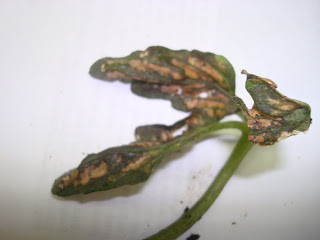Several States have now reported evergreen injury (mainly spruce and white pine) due to either, herbicide or environmental factors.
Symptoms include: wilted, necrotic, yellow, needles; needle death, wilting of new shoots; desiccated and drooping candles; twisting and distorted shoots
One of the main topics of discussion is the injury of spruce and white pine, in some cases, which has been linked to to the herbicide, Imprelis (DuPont). Imprelis is a newly, released lawn herbicide with excellent soil activity. It is also important to note, that not all spruce and white pines have been injured in areas where Imprelis herbicide has been applied.
Be aware that all herbicides with good, soil activity could be a potential danger to evergreens and broadleaf ornamentals, if root uptake occurs.
DuPont Imprelis Label: http://www2.dupont.com/Professional_Products/en_US/assets/downloads/pdfs/H65717.pdf
DuPont Imprelis Label: http://www2.dupont.com/Professional_Products/en_US/assets/downloads/pdfs/H65717.pdf
The Imprelis label states: “Do not apply this product directly to, or allow to be under, ornamental ground covers, foliage plants, flowers, nearby crops or other desirable plants; or to the soil where potentially sensitive plants will be planted during the same season. Do not exceed specified application rates for any area and particular care should be taken within the dripline of trees and shrubs.” In addition, the Imprelis label states that grass clippings are not to be used as mulch or put into compost piles.
DuPont has made a statement. See more in the link below:
http://www.ksuturf.org/blog/2011/06/possible-herbicide-injury-to-spruces-and-pines/
DuPont has made a statement. See more in the link below:
http://www.ksuturf.org/blog/2011/06/possible-herbicide-injury-to-spruces-and-pines/
Here are some other links to fact sheets, blogs, and pictures with further information on this topic.
Purdue fact sheet: http://www.ppdl.purdue.edu/PPDL/hot11/6-10.html
There have been several other reports of evergreen injury (spruce) linked with herbicides that contain (2, 4-D, Mecoprop and Dicamba) as well as "auxin" or phenoxy herbicides.Why is this herbicide injury happening this growing season? Could environment or weather be a factor? There is speculation that spruce may be stressed from the drought of last fall and could be more susceptible to injury of all kind (diseases, insects, and herbicides). There was alot of rain this season that could move chemicals to roots of plants for uptake. In addition, was it a coincidence that symptoms started to occur when there was a sudden temperature fluctuation from low 40 degrees F to 90 degrees F?
Lastly, there have been reports of some of these same evergreen symptoms in areas where NO HERBICIDES have been applied. Late freezes can cause death of new growth. It possible that hot, dry winds or "tornado like winds", as well as a cold to hot temperature extreme can cause evergreens, such as spruces, to have uniform candle dieback or dessication of needles.
Since the environment could be to blame for some of the same symptoms described on spruce, you have to very, careful before you jump to the conclusion of herbicide injury. However, it appears that the "twisting" and "distortion" of evergreen seems to be a common symptom of suspected herbicide injury cases.













